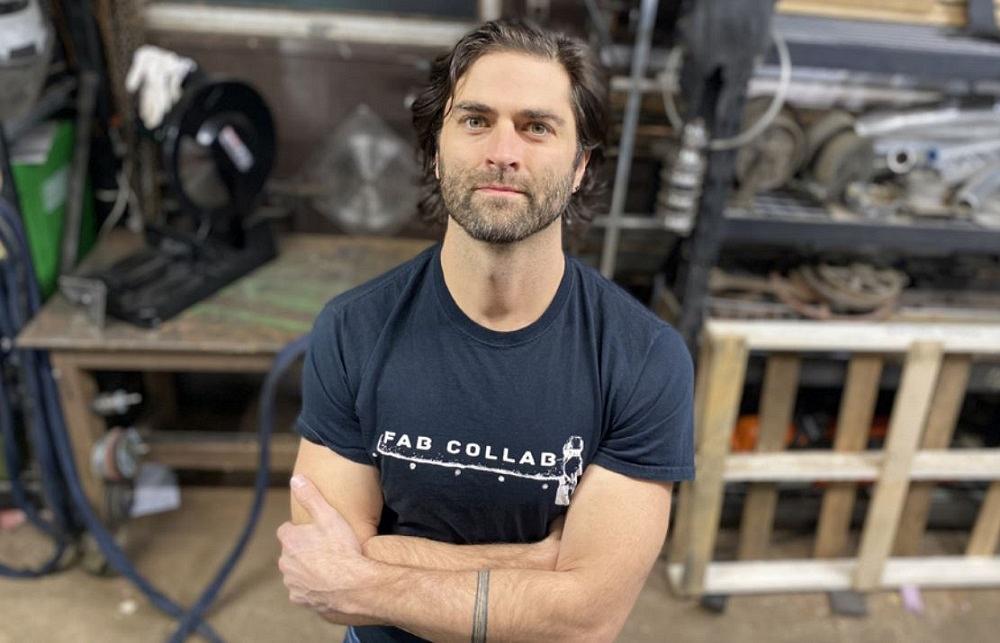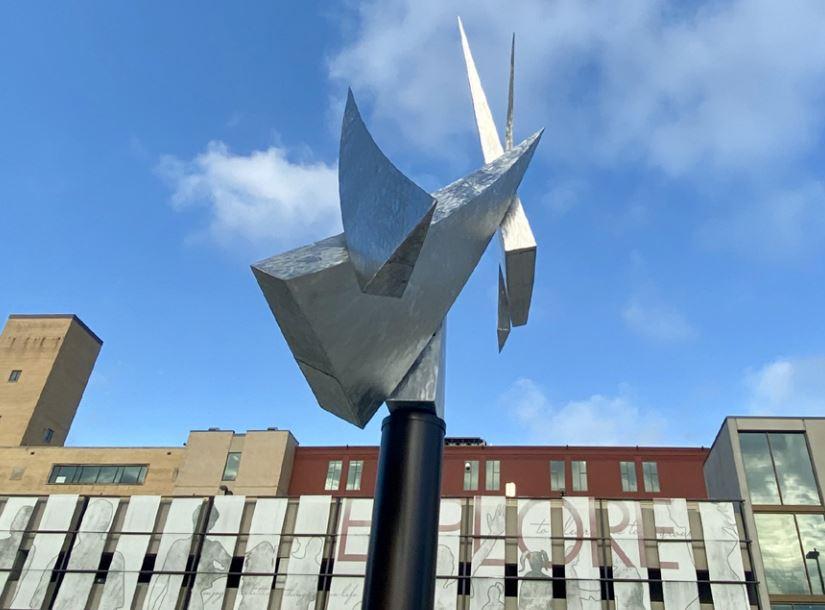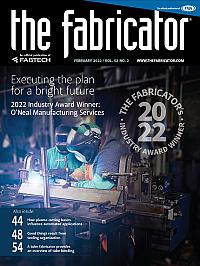- FMA
- The Fabricator
- FABTECH
- Canadian Metalworking
Categories
- Additive Manufacturing
- Aluminum Welding
- Arc Welding
- Assembly and Joining
- Automation and Robotics
- Bending and Forming
- Consumables
- Cutting and Weld Prep
- Electric Vehicles
- En Español
- Finishing
- Hydroforming
- Laser Cutting
- Laser Welding
- Machining
- Manufacturing Software
- Materials Handling
- Metals/Materials
- Oxyfuel Cutting
- Plasma Cutting
- Power Tools
- Punching and Other Holemaking
- Roll Forming
- Safety
- Sawing
- Shearing
- Shop Management
- Testing and Measuring
- Tube and Pipe Fabrication
- Tube and Pipe Production
- Waterjet Cutting
Industry Directory
Webcasts
Podcasts
FAB 40
Advertise
Subscribe
Account Login
Search
Dynamic metal sculpture an outcome of artist’s vision, engineering expertise
Close collaboration culminates with unpredictable motions for Green Bay, Wis., artist
- By Eric Lundin
- February 19, 2022
- Article
- Laser Cutting
Regardless of the medium they use, artists often find inspiration close to home. Claude Monet’s “Impression, Sunrise” depicts boats in the harbor in his hometown, Le Havre, France. Ansel Adams’ career as a landscape photographer got a start when he published several shots of the Yosemite Valley, where he had found a summer job as a teenager. And although Pablo Picasso was no longer living in Spain in 1937, he nonetheless created his most famous painting about the bombing of Guernica.
When metal artist Kent Hutchison set out to create a kinetic sculpture that would capture the essence of his hometown, Green Bay, Wis., he didn’t have to look far to find inspiration. Lake Michigan and the Fox River play large roles in the economy and culture of Green Bay and the surrounding communities, so a nautical theme was a natural choice.
He didn’t want to create a static sculpture. His intention was to make something dynamic, something with a lot of motion. Artists often seek to draw attention to a drawing, painting, or sculpture with a detail that is especially interesting, compelling, or even puzzling, creating a feeling of tension on the part of the viewer. This was Hutchison’s aim.
He wanted the motion to be dramatic and peculiar. He wanted to captivate the viewers.
Falling Apart, Coming Together
Hutchison envisioned an abstraction of a boat. Named “Embark,” it would be a collection of five contoured, dynamic sails that would draw energy from the wind. Four of the sails would be free to move on horizontal axes, and the entire sculpture would rotate about a sail on a vertical axis, like a wind vane. In effect, he would create two layers of motion, unpredictable dynamic actions, a sculpture that seemed to be on the verge of falling apart before coming back together.
Getting a project like this from concept to commission isn’t necessarily easy, but the city of Green Bay has everything it needs. According to Hutchison, the city is large enough to create and sustain interest in public art; its public arts commission is staffed with bona fide artists; and the various municipal departments involved in reviewing and approving such proposals have a streamlined system.
The only holdup after getting the approval was that Hutchison really didn’t know how he’d go about creating it. Mass, friction, surface area, wind load, inertia—these are engineering concepts, not artistic ones. He’d need an engineering degree to tackle this.
Greater Than the Sum of Its Parts
“I must have called 25 firms to ask for some assistance, and I finally found Infinity,” he said, referring to Infinity Machine & Engineering, a company that specializes in making paper and pulp machinery. Located nearby in De Pere, Wis., and headed by an executive with a strong interest in the arts, Infinity was the right call. Hutchison’s description of the project captured the attention of Scott Santaga, the CEO at that time, and he was more than willing to donate the engineering resources for the project. It wasn’t long before Hutchison was in touch with one of the company’s engineers, Todd Hanson, who took about six weeks to design the guts of the project.
“I had a limited budget,” Hutchison said. “I have no idea what I would have done without Scott’s backing and Todd’s efforts.”
The effort shows in the results. The main sail alone has more than 500 lbs. of material in it, yet each of the sails is so well counterbalanced that the structure moves a lot, even when the winds aren’t very strong.

Metal sculptor Kent Hutchison’s shirt says it all: Fab collab. In addition to donated engineering time and parts cut at a steep discount, “Embark” was possible only with some collaboration with a local fabrication shop that has a high-powered welder that could handle some one-pass welds beyond the range of Hutchison’s equipment.
“Sails 3 and 5 are the smallest and can move in winds that are just 5 MPH,” Hutchison said. “Sails 2 and 4 get going when the wind is 10 to 15 MPH, and when the winds are up to 20 MPH, it’s really dancing,” he said. And it’s quiet, he added. Hanson spared no expense, using high-quality bearings that produce no discernible sound.
It has built-in stops to prevent too much motion, keeping the sails pitched at less than 45 degrees. The stops are covered with a layer of polyurethane to absorb the energy and bring the motion to a slow stop. That said, the internal workings rarely hit the stops.
“I’ve seen ‘Embark’ in motion on days when the wind was more than 50 MPH and the motion was still fluid and elegant,” he said. “The sails pitch over and shed the wind load and the motion slows, usually before it hits the stops.”
In addition to Infinity, Hutchison credits Ken Destiche, president of LaserForm LLC, De Pere, for his generous support. The company used its laser and waterjet machines to cut the parts at about half the normal hourly rate.
Motion and Emotion
It turned out that the sculpture’s motion is just as Hutchison had intended. Although wind comes from only one direction at a time, the four sails on horizontal axes develop their own motions and seem to be nearly independent of each other. Meanwhile, the sail attached to the pedestal doesn’t seem to be buffeted by the wind; it almost appears to have a mind of its own, actively scanning left and right, as though it were looking for something.
“The kinetic motion of the project is exactly as I had envisioned it,” Hutchison said.
About the Author

Eric Lundin
2135 Point Blvd
Elgin, IL 60123
815-227-8262
Eric Lundin worked on The Tube & Pipe Journal from 2000 to 2022.
subscribe now

The Fabricator is North America's leading magazine for the metal forming and fabricating industry. The magazine delivers the news, technical articles, and case histories that enable fabricators to do their jobs more efficiently. The Fabricator has served the industry since 1970.
start your free subscription- Stay connected from anywhere

Easily access valuable industry resources now with full access to the digital edition of The Fabricator.

Easily access valuable industry resources now with full access to the digital edition of The Welder.

Easily access valuable industry resources now with full access to the digital edition of The Tube and Pipe Journal.
- Podcasting
- Podcast:
- The Fabricator Podcast
- Published:
- 04/16/2024
- Running Time:
- 63:29
In this episode of The Fabricator Podcast, Caleb Chamberlain, co-founder and CEO of OSH Cut, discusses his company’s...
- Industry Events
16th Annual Safety Conference
- April 30 - May 1, 2024
- Elgin,
Pipe and Tube Conference
- May 21 - 22, 2024
- Omaha, NE
World-Class Roll Forming Workshop
- June 5 - 6, 2024
- Louisville, KY
Advanced Laser Application Workshop
- June 25 - 27, 2024
- Novi, MI
































